|
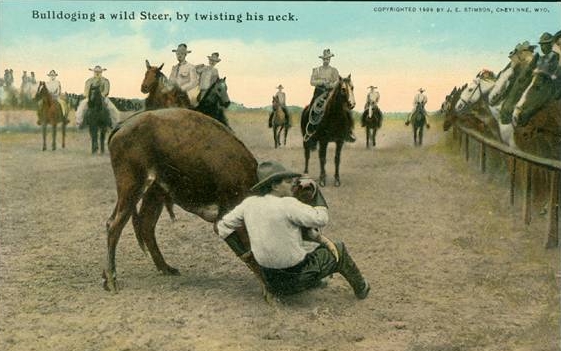
Bulldogging. Postcard by J. E. Stimson, 1909.
An article in Union Pacific Magazine, July 1929. detailing the history of Frontier Days,
How Frontier Days Became a Great Classic, noted that over the years,
Roping and bulldogging have been speeded up to such a point that faster steers
came into being to keep pace with the game. some ranchers are now raising
a breed of wide-horned, leggy cattle, useless for an;ything but show purposes, but
very valuable there. These ranchers are steer specialists, producing expert
steers. The animals are exercised, and fed a grain ration. they are fleet as a
saddle horse, weight around 1,200 pounds each, are are of a pinto design, similar to the
appaloosie ponies popular with the Indians.
As noted in the program for the 1936 World's Championship at the Boston Garden:
According to all the traditions of Rodeo, Bill Pickett, a cotton-picking Negro on a
Texas ranch along the Rio Grande, was the first steer wrestler.
This hazardous method of stopping a refractory steer seems to have come about
by accident. Bill, a capable cow hand, was trying to drive a steer into a corral. The animal
dodged the gate several times, until Bill lost his usually placid temper.
To the amazement of the onlookers, Bill urged his poney forward until he was
abreast of the steer. Then, leaping from the saddle, Bill grabbed the steer by a horn
with one hand and slid the other arm around the animal's neck. Using the
horn as a fulcrum, Bill, after stopping the steer, threw the animal to the
ground. When the steer was released, it trotted meekly into the corral, which was all
that Bill wanted.
Pickett's steer-wrestling act was featured in Rodeos. Clay McGonigal and one or two other
cowboys essayed the stunt successfully. Other cowboys followed and soon
steer wrestling very deservedly became one of the high spots of Rodeo.
In addition to Tom Mix noted on the previous page, Frontier Days attracted many of the leading
rodeo stars including many from the Miller Bros. 101. Following the demise of
Buffalo Bill's Wild West, the Miller Bros. out of Ponca City, Oklahoma, was the leading
western show.
With the publicity given the show by Col. Roosevelt's 1910 visit to the show, Frontier Days rapidly became the
foremost rodeo in the country attracting luminaries from Los Angeles such as Doublas Fairbanks,
Will Rogers, and Fred Stone.
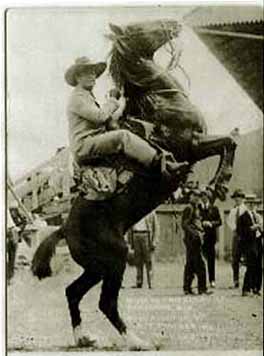 . . . . . . 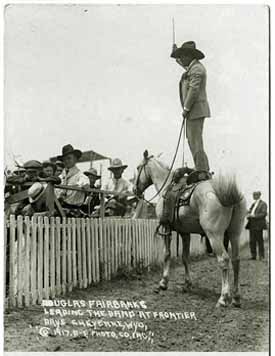
Douglas Fairbanks at Frontier Days, 1917. Photos by Ralph Doubleday.
Fairbanks had come to Wyoming in order to film a movie "Handsome Jim Sherwood." His company included
Hugh Strickland, the 1916 Bucking winner at Frontier Days.
In 1919, Fred Stone (1873--1959), famous comedian and screem actor, arrived in Cheyenne for the show accompanied by an entourage of
30 including cameramen and movie equipment. He entered several contests including the bulldogging contest and wild horse race.
Stone did not have a particularly good time in either contest. In the bulldogging on his first try, he was thrown over the animal.
On the second try, he brought down the beast but his time was not particularly good, 2 minutes 21 seconds.
After bringing the animal down, The animal, after being, released turned on Stone threatening to trample and gore Stone to death.
Stone was rescued by some of the cowboys. In the wild horse race, Stone was permitted to have his horse saddled in advance, unlike others in the
race. Even with this advantage, Stone finished fourth. For a quarter of the distance around the tract his horse
went in the wrong direction. Later, Stone painted his face red and joined the Indians in the Sun dance.
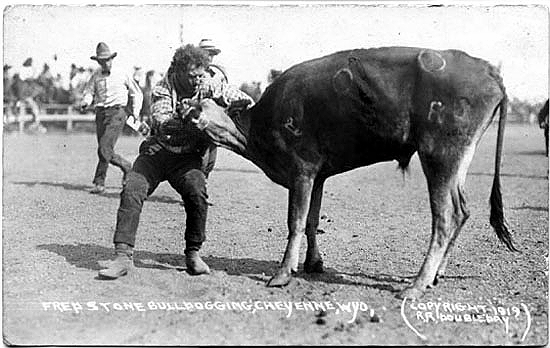
Fred Stone, 1919, photo by Ralph Doubleday
Stone was a mutual friend of both Will Rogers and
C. B. Irwin and served as an honorary pall bearer for Irwin. Stone was born in Longmont, Colo., and joined the W. W. Cole Circus
at age 11. By 1902, he played the part of the Scarecrow in the Broadway production of the
Wizard of Oz. He and Rogers would sometimes appear on the same Vaudeville bill. The two shared a mutual love of
steer roping, polo, and flying. One of Roger's children was named Fred Stone Rogers. The two wrote with Elsie Jamis introductions to the
1928 book Roping Trick and Fancy Rope Spinning. Stone appeared in over 70 motion pictures including
Samuel Goldwyn's 1940 The Westerner.
Notwithstanding Fred Stone's performance, Tom Henderson probably put in the most exciting and tenacious performance in the 1919 bulldogging contest.
The State Leader, July 24, 1919, described Henderson's losing performance:
In spite of being dragged and bulldogged by the steer which he was attempting to bulldog, Tom Henderson of
Boulder, Colo. clung to the steer's horns and struggled with him with such grit
that it brought the crowds that filled Frontier park grandstands yesterday afternoon to their feet cheering.
Henderson's battle with the steer, which terminated when he succeeded in downing the animal after 3 minutes, 37 and two-fifths seconds was the most
dramatic expoit in the opening program of the twenty-third annual Frontier Days celebration.
Henderson plunged from his horse to the steer's horns successfully, but the steer was a fighter and almost broke away.
TENACIOUS AS A BULLDOG
The bulldogger kept his grip with one hand and the steer dragged him about on his back for nearly a minute. For a few seonds Henderson was in great
danger of being gored as the steer pinned him to the ground between its horns and the
spectators held their breath, but he managed to get the upper hand again and soon
had the steer on its side. The creature got up again, however, and the bulldogger was forced to ride stretched across its horns for more than half a minut before he got the animal down
finally. After the thrilling struggle was over Henderson was assisted from the arena.
As indicated in the next photo, Stone and Henderson were not
the only ones who found the bulldogging contest difficult.
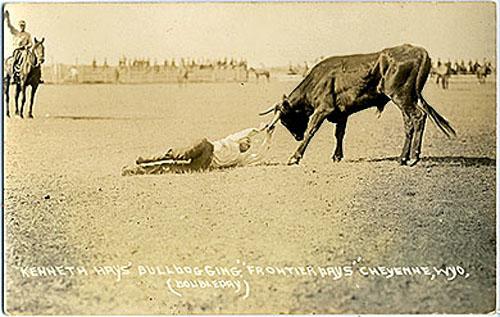
Kenneth Hays in bulldogging contest, undated, photo by
Ralph Doubleday
By 1930, excess time such as in Stone's and Hunderson's performances had been eliminated.
The Bulldogging Contest had been made a timed event, limited to two minutes. The 1930 rules provided:
Steer to be given thirty-foot start. Bulldogger will start from behind barrier which will
be released when steer crosses thirty-foot mark. If constestant accidentally breaks the barrier a penalty of
TEN SECONDS will be added to his time. If he deliverately breaks it, he is OUT OF THE CONTEST Each contestant
must furnish his own horse and hazer. Steers wil be drawn for at the cutes on day contestant is scheduled to perform.
After catching steer, bulldogger must bring it to a stop and twist it down. If steer is
accidently knocked down or thrown down before being brought to a stop, or is thrown by bulldogger putting animal's horns into the ground
it must be let up on four feet and then thrown. Steer will be considered down only when it is lying flat on its side, all
four feet out and head straight. The fairness of the catch and throw will be left to the judges and their decision
will be final. Bulldogger, after throwing a steer, must signal his finish to the judge with one hand while holding steer down with the
other and must not release steer until told to do so by the judge. If bulldogger loosens or knocks off a horn, TEN SECONDS will be
added to his time as penalty.
Hazer must retire from field as soon as bulldogger catches steer and must not render and assistance to contestant while contestant is working with steer.
There will be a time limit of two minutes in this contest. If bulldogger has not caught and thrown his steer in two minutes, he will retire from arena on signal and given no time.
In 1920, Will Rogers came to the show without, however, advance men,
publicity, or the entourage that had accompanied Fred Stone. He was accompanied by cowboy "Big Boy" Wiliams.
Williams in later movies played "side kick" to Roy Rogers. Will Rogers' presence was almost
unnoticed. It was totally ignored by the State Leader. It was noted by the State Tribune
on page 9 of the July 29 edition, buried at the at the tail end of
an article on the wild horse race:
Will Rogers was there. The famous trick roper and stage movie comedian appeared in a brown
suit and on a brown horse, and man, suit and horse would attract about as much attention as a bottle
of near beer in the good old days. Not until Dan Dix, announcer and comedy mule rider began noising
around the fact in the press stand did anybody get busy. Members of the Frontier
committee argued long and hard to get Rogers to appear in th limelight of the quarter stretch, even if only
to make his bow to the public, but they argued in vain.
One bronco rider, Ray Bell (1899-1996), came to the attention of Will Rogers. In the bronco contest, Bell was tossed.
Rogers and Williams accompanied Bell home where the three had an afternoon of roping. Unfortunately,
Rogers' clothes were ruined. Bell took Rogers to a clothing store. Rogers' new trousers needed to be cut to lenth and
cuffed. The proprietor indicated to Rogers that he would have the new trousers ready in about an hour or so.
Rather than wait, Rogers put the trousers on a table and with scissors simply cut the trousers off without
hemming, put them on and left the store. From that meeting, a friendship developed which eventually led Bell to the
lights of California and fame as a horse trainer.
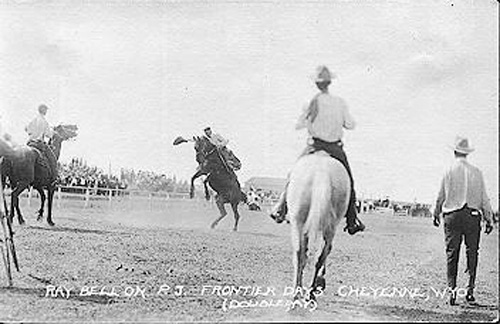
Ray Bell. Photo by Ralph Doubleday.
Bell had participated in rodeos since at least 1915. In 1920, Ray placed first at Pendleton and
Boise. In 1921, he placed first in the bronco contest at Boise and first in roping. In 1922, Ray placed first at San Antonio and
Second at Fort Worth. In 1923 at Pendleton, Bell won the World Saddle Bronc Championship.
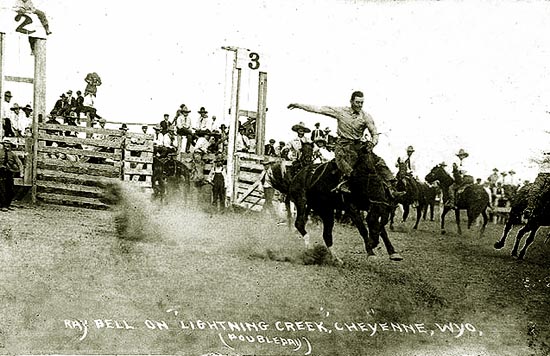
Ray Bell. Photo by Ralph Doubleday.
In California, Bell worked for a while as a stunt double and later as a horse trainer. Among those he trained
horses for were movie mogul Louis B. Mayer and actor and singer Bing Crosby. Additionally he acted as a commission buyer
for Mayer. He ultimately owned and trained three champion thoroughbreds including a Kentucky Derby contender. His son and
grandson carried on the horse training business.
Next page, Frontier Days continued,
|